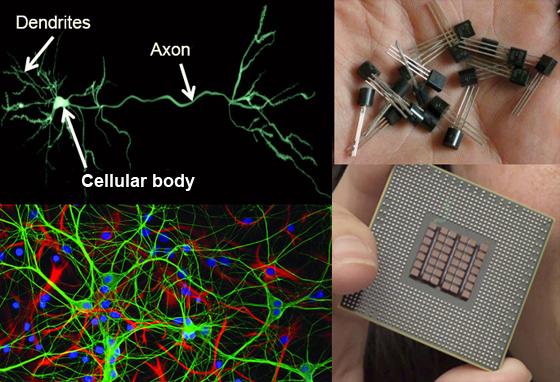Tuesday, 21 July 2020
How neuronal communication began, and how brains differ from computers
 When you move through space, your sensory perceptions change constantly, in real time. What we call cognition can be equated with this uninterrupted flow of perception and action through by a body and a brain located in an environment. But as scientists have now told us, the modern human brain contains many neurons that are neither sensory nor motor—so many that it can sometimes be hard to realize that this perception/action loop is still the foundation of the nervous systems of primates and other animals. These interneurons, as they are called, receive nerve impulses from sensory neurons and transmit signals to other neurons, and so on. And at some point in time, after all sorts of indescribably complex detours, a motor neuron will receive signals from some of these interneurons and then be able to command a muscle to contract to make a body part move.
When you move through space, your sensory perceptions change constantly, in real time. What we call cognition can be equated with this uninterrupted flow of perception and action through by a body and a brain located in an environment. But as scientists have now told us, the modern human brain contains many neurons that are neither sensory nor motor—so many that it can sometimes be hard to realize that this perception/action loop is still the foundation of the nervous systems of primates and other animals. These interneurons, as they are called, receive nerve impulses from sensory neurons and transmit signals to other neurons, and so on. And at some point in time, after all sorts of indescribably complex detours, a motor neuron will receive signals from some of these interneurons and then be able to command a muscle to contract to make a body part move.
What distinguishes the nervous system from other communication systems in the human body, such as the endocrine and immune systems, is its speed. The time that elapses between a perception and a suitable bodily action in response can be a second or less. How do the myriad neurons in the nervous system manage to communicate with one another so rapidly?
In this regard I will refer to a 2014 article by Antonio Damasio and his colleagues that I discussed in an earlier blog post entitled From membrane excitability to subjective consciousness. These authors had investigated the nature of the disturbances that might alert a sensory nerve cell that something that concerned it was happening in its environment. These authors found that the process always started with a massive influx of small, positively charged ions, essentially sodium (Na+) and calcium (Ca2+), into the nerve cell. Furthermore, they found that along the entire chain of transmission from neurons to neuron and ultimately to the muscles, this influx of positive ions was always the first event that occurred in a cell before the molecular mechanisms specific to each subsequent step of neuronal communication were triggered. And that’s what led them to think that a massive intrusion of sodium or calcium ions, which are abundant in the marine environment where life began, may have been the first direct signal telling the inside of a cell that something was going on outside—for example, that ions were flooding in because a predator had eaten a hole in its cell membrane, and that it had better trigger a movement to get away from this danger.
According to Damasio and his co-authors, this grounding of animal cognition in the most fundamental processes of life also explains why artificial intelligence, implemented in electronic circuits in which the flows consist of electrons, cannot have sentience in the sense that we understand animals to have it. Because these microprocessors, even though they process inputs and produce outputs in a way that is often very similar to what happens inside animal brains, do not have the intrinsic concern for their own survival that we have here seen to be associated with the inflow of positive ions into nerve cells.
Obviously, there are many other things that distinguish a brain from a computer in terms both of the “hardware” of these two systems (the number of elementary units that they contain, the degree of conductivity between them, their processing speed, etc.) and of their flexibility or plasticity. Not to mention that whereas computers perform digital computations, animal brains perform computations that are neither entirely digital nor entirely analog, but instead of a mixed type called “neuronal”. All of these considerations provide fodder for what are still very fierce debates in the cognitive sciences, such as the extent to which the brain can be said to perform computations, and what that word really means.
From the Simple to the Complex | Comments Closed







